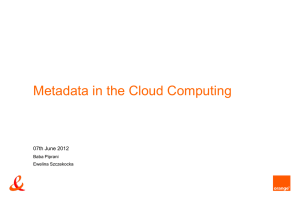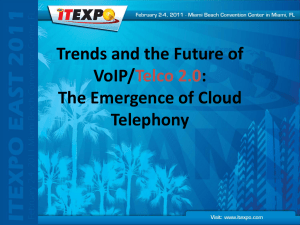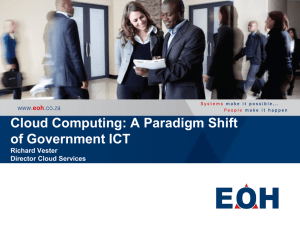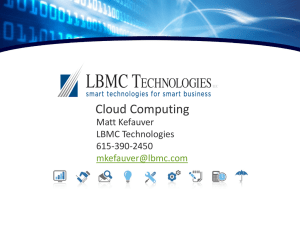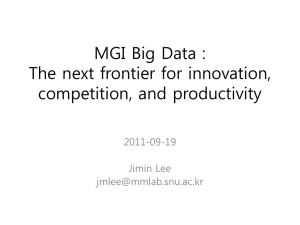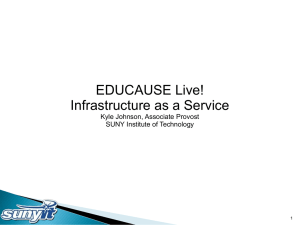Presentation Slides
advertisement
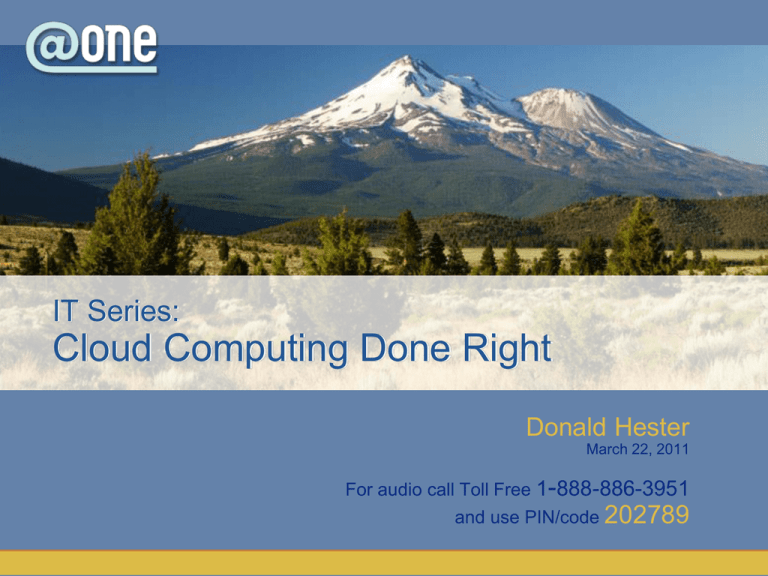
IT Series: Cloud Computing Done Right Donald Hester March 22, 2011 For audio call Toll Free 1-888-886-3951 and use PIN/code 202789 Housekeeping • Maximize your CCC Confer window. • Phone audio will be in presenter-only mode. • Ask questions and make comments using the chat window. Adjusting Audio 1) If you’re listening on your computer, adjust your volume using the speaker slider. 2) If you’re listening over the phone, click on phone headset. Do not listen on both computer and phone. Saving Files & Open/close Captions 1. Save chat window with floppy disc icon 2. Open/close captioning window with CC icon Emoticons and Polling 1) Raise hand and Emoticons 2) Polling options IT Series: Cloud Computing Done Right Donald Hester Image: NASA Cloud Computing? The “Cloud” Nebulous • Buzz word • Overused cliché • Ill defined • Many different definitions • Marketing term • All hype • The “unknown path” • Service provider 8 What is it? “..[a] model for enabling convenient, on-demand network access to a shared pool of configurable computing resources (e.g. networks, servers, storage, applications, services) that can be provisioned and released with minimal management effort or service provider interactions.” NIST & Cloud Security Alliance A utility model of technology delivery. 9 Cloud Flavors • Private Cloud • Operated solely for one organization • In-sourcing • Community Cloud • Operated for a group of similar organizations • Public Cloud • Outsourced • Multi-tenant • Hybrid Cloud • Combination of the above 10 …as-a-service • • • • • • • • 11 Communication-as-a-Service (CaaS) Infrastructure-as-a-Service (IaaS) Monitoring-as-a-Service (MaaS) Platform-as-a-Service (PaaS) Software-as-a-Service (SaaS) Security-as-a-Service (SECaaS) Everything-as-a-Service (EaaS) Anything-as-a-Service (XaaS) …as-a-service 12 Potential Spending on Cloud Computing Federal Cloud Computing Strategy Based on agency estimates as reported to the Office of Management and Budget (OMB) 13 Federal Cloud Computing Strategy “Cloud First policy. This policy is intended to accelerate the pace at which the government will realize the value of cloud computing by requiring agencies to evaluate safe, secure cloud computing options before making any new investments.” “…to be more efficient, agile, and innovative through more effective use of IT investments…” Federal Cloud Computing Strategy, February 2011 14 Benefits of Cloud Computing • Save time and money on provisioning new services • Less time spent on deployment • Move capital investment to operational expenses • Instant test bed • Enables IT systems to be scalable and elastic • Provision computing resources as required, on-demand • No need to own data center infrastructure (for public cloud service) 15 Benefits of Cloud Computing • Energy saving (green) • Increased utilization, less idle time • Cost based on usage • More effective use of capital resources ($) • Better service • Allows IT staff to focus on core competencies • Repurpose IT staff for more customer service • Outsource to esoteric experts • 24/7 service and support • Economies of scale 16 Federal Cloud Computing Benefits 17 Federal Cloud Computing Strategy, February 2011 Cost Benefit Analysis Traditional Costs Hardware (initial) Software (initial) Hardware repair/upgrades Software upgrades Staff costs Energy costs Training Cloud Costs Cost per user Cost by bandwidth/storage Cost increase over time Cost of additional services Legal consultation costs Staff costs Training Traditional Limits Maximum load Maximum up-time Maximum users MTTR Dependencies Cloud limitations Users Bandwidth Storage Service Support Dependencies 18 Cost Benefit Analysis Example Traditional Costs TCO $21,000 19 Cloud Costs TCO $22,850 Cost Benefit Analysis Example TCO over 10 years: MS Office Retail $1,220 MS Office Academic $346 MS Office 360 $295 20 Cloud Risks Where’s My Data? The Bad Divorce Trust but Verify “I thought you knew” I didn’t think of that Clarify Consider Expectations, Put it in Writing 21 Where’s My Data? • In the information age your key asset is information. • Some information requires protection • (Credit Card Data, Student Records, SSN, etc…) • Your information could be anywhere in the world • You may loss access to your data • ISP failure • Service provider failure • Failure to pay (service provider stops access) 22 The Bad Divorce “Vendor Lock” • All relationships come to an end • Let you down, had a breach, SLA performance etc… • The company fails/gets sold • Introductory pricing or it goes up over time • Transition to new vendor or in-source • How will you get your data back? • Get a prenup – get it in the contract up front 23 Trust but Verify Assurance • How do you know they are protecting your data? • Not everyone is treated the same by service providers • Disclosure concerning security posture • 3rd party independent verification (audit/assessment) • SAS 70 / SSAE 16 • SysTrust / WebTrust • ISO 27001 Certification • Audit / Assessment 24 “I thought you knew” Breach Notification • When do you want to know about a data breach? • (Data that you are legal obligated to protect) • Typical contracts give wide latitude for service providers • Actual verses possible breach • Timeliness of notification 25 I didn’t think of that Dependencies • Infrastructure – Internet • Authentication management (SSO) • Operational budget • Greater dependency on 3rd parties Other considerations • Complex legal issues • Multi-tenancy • Transborder data flow 26 Clarify • • • • • 27 What do they mean by “Cloud” Establish clear responsibilities and accountability Your expectations Cost of compensating controls What will happen with billing disputes Consider • The reputation of the service provider • Track record of issues • Large or small, likelihood of change • Vendor ‘supply chain management’ issues • The reliability of the service or technology • Is the technology time tested • Typically you have no control over upgrades and changes • Training for staff 28 Expectations, Put it in Writing • Anything they guarantee get in writing • Typical agreements are in favor of the service provider • Protect your interests in writing (have legal look at it) • Get specific SLA • Document specific security requirements • Non-performance clause • Disposition and transition clauses • Notification requirements 29 Resources Cloud Security Alliance • cloudsecurityalliance.org ISACA: Cloud Computing Management Audit/Assurance Program, 2010 NIST Special Publication 800-145 (draft) Federal Cloud Computing Strategy, February 2011 Above the Clouds managing Risk in the World of Cloud Computing by McDonald (978-1-84928-031-0) Cloud Computing, Implementation, Management, and Security by Rittinghouse and Ransome (978-1-43980680-7) 30 Q&A Donald E. Hester CISSP, CISA, CAP, MCT, MCITP, MCTS, MCSE Security, Security+, CTT+ Director, Maze & Associates University of San Francisco / San Diego City College / Los Positas College www.LearnSecurity.org | www.linkedin.com/in/donaldehester | www.facebook.com/LearnSec | www.twitter.com/sobca | DonaldH@MazeAssociates.com Evaluation Survey Link Help us improve our seminars by filing out a short online evaluation survey at: http://www.surveymonkey.com/s/CloudComput IT Series: Cloud Computing Done Right Thanks for attending For upcoming events and links to recently archived seminars, check the @ONE Web site at: http://onefortraining.org/


